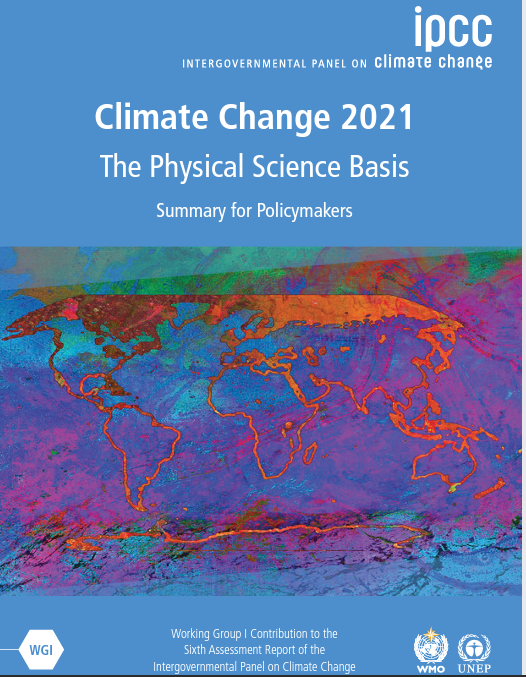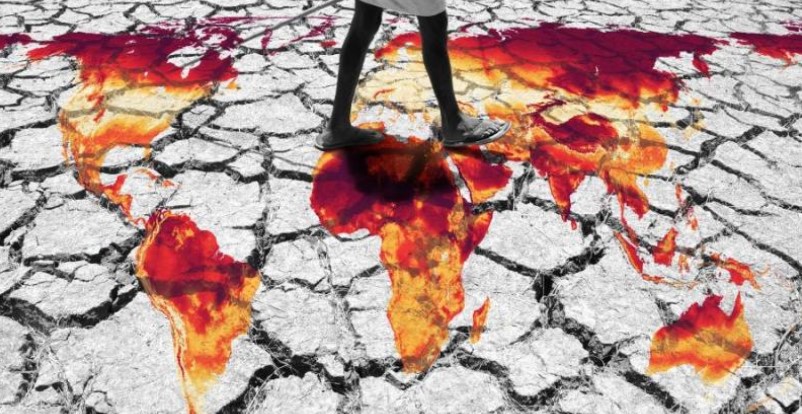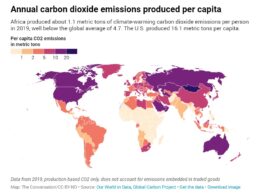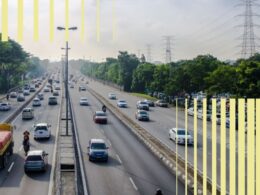Each degree of warming above present levels corresponds to roughly 1bn people falling outside of ‘climate niche’
Financial Times
Steven Bernard, Dan Clark and Sam Joiner
NOVEMBER 1 2021
Infographic / Selected image

Up to 3bn out of the projected world population of about 9bn could be exposed to temperatures on a par with the hottest parts of the Sahara by 2070, according to research by scientists from China, US and Europe.
However, rapid reductions in greenhouse gas emissions could halve the number of people exposed to such hot conditions.
“The good news is that these impacts can be greatly reduced if humanity succeeds in curbing global warming,” said study co-author Tim Lenton, climate specialist and director of the Global Systems Institute at Exeter university.
The report highlights how the majority of humans live in a very narrow mean annual temperature band of 11C-15C (52F-59F).
Researchers noted that despite all innovations and migrations, people had mostly lived in these climate conditions for several thousand years.
“This strikingly constant climate niche likely represents fundamental constraints on what humans need to survive and thrive,” said Professor Marten Scheffer of Wageningen University, who co-ordinated the research with his Chinese colleague Chi Xu, of Nanjing University.
Global warming has resulted in a 1.1C rise in temperatures since pre-industrial times, according to scientists.
This is expected to reach 1.5C within 20 years, even in the best-case scenario of deep cuts in greenhouse gas emissions.
“Each degree of warming above present levels corresponds to roughly 1bn people falling outside of the climate niche,” Lenton noted.
“Each degree of warming above present levels corresponds to roughly 1bn people falling outside of the climate niche” — Lenton.
At present, only 0.8 per cent of the global land surface experiences mean annual temperatures greater than 29C (84.2F).
If emissions continue to rise, this could spread to 19 per cent of the planet’s land area by 2070, under the worst-case scenario set out by the Intergovernmental Panel on Climate Change, the UN scientific body.
What are the scenarios?
Three different climate scenarios and three population projections are set down by the IPCC in its landmark report assessing climate change (see table below).

Sixth Assessment Report
The Working Group I contribution to the Sixth Assessment Report addresses the most up-to-date physical understanding of…www.ipcc.ch
To visualise how liveable the earth will be in 2070 under these scenarios, the Financial Times has paired the population projections with each climate model and mapped them across six continents.
The respective models “are developed without accounting for feedback between each other”, explained Jing Gao, assistant professor of geospatial data science at the University of Delaware.
In the so-called shared socio-economic pathways (SSPs), “we talk about different societal trends, including population, economic development, governance, and other related aspects — but they do not already account for how people will react to climate change,” she said.
All the scenarios are idealised futures, she noted, but this is a common practice with scenario analysis. “They are all possible while sometimes reflecting extreme cases. Using several widely diverging scenarios together help capture the range of uncertainty.”
Representative Concentration Pathway (RCP)
RCP 2.6 — aims to limit the increase of global mean temperature to 2C
RCP 4.5 — aims to stabilise radiative forcing at 4.5W per square metre (approximately 650 ppm CO2-equivalent). This compares with the current level of about 400 ppm
RCP 8.5 — is a very high baseline emission scenario, where emissions continue to rise with no policy-driven mitigation

Shared socio-economic Pathway
SSP 1 — a shift towards a more sustainable path, reduction in global inequality with lower resource and energy intensity consumption
SSP 2 — business as usual, in which social, economic and technological trends do not shift markedly from historical patterns
SSP 5 — fossil fuels play a major role in strong economic growth, coupled with high resource and energy intensive lifestyles
- Under the most extreme scenario, the US southern states would become much hotter by 2070, particularly those that border the Gulf of Mexico.
- Central America would bear the brunt of the increased temperatures, with up to 20m people living in mean annual temperatures of 29C.
- Large parts of Canada and Alaska below the Arctic Circle would experience warmer conditions by 2070. These areas are now largely uninhabited and projected to remain that way without factoring in migration.
- Large areas of the Amazon rainforest in Brazil, along with surrounding countries Peru, Colombia and Venezuela, would be virtually unliveable because of extreme heat by 2070.
About 59m people would be affected by these conditions — or about 12 per cent of the continent’s projected population under the most extreme scenario.
- Europe is predicted to be the only continent to avoid mean annual temperatures exceeding 29C.
- However, large areas of Scandinavia, eastern Russia and countries bordering the Mediterranean could still expect to see temperatures increase by up to 5C by 2070 under the worst-case scenario (RCP 8.5).
- Africa’s population is predicted to experience a population explosion in all the shared socio-economic pathway scenarios, doubling from 1.2bn to almost 2.4bn people.
- Sub-Saharan nation Nigeria is likely to become the world’s third-most populous country by the middle of this century, surpassing the US.
Its largest city, Lagos, would be on course to be the largest city in the world by population in 2075 with 61.5m inhabitants based on a middle scenario (SSP 2).
- About 81 per cent of Nigeria’s predicted population of about 477m would suffer from these extreme temperatures.
This might force huge numbers to migrate but is very difficult to predict. “Foreseeing the actual magnitude of climate-driven migration remains challenging,” said Scheffer. “People prefer not to migrate. Also, there is scope for local adaptation in part of the world within limits, but in the global south this will require boosting human development rapidly.”
- Asia’s population is predicted to swell to more than 5bn by 2070, and a large number of countries would experience mean annual temperatures in excess of 29C.
Worst affected would be India, with a population that could reach 1.6bn, more than half of whom would experience this extreme heat.
- Almost all of the United Arab Emirates and Cambodia would become nearly unliveable, including the heavily populated areas of south Vietnam and eastern Pakistan.
- Oceania’s extreme heat would be confined to the largely unpopulated areas of Papua New Guinea and northern Australia, with the majority of Australia’s population remaining predominantly situated along the south and eastern coastline.
Large areas of the Amazon rainforest in Brazil, along with surrounding countries Peru, Colombia and Venezuela, would be virtually unliveable because of extreme heat by 2070.
About 59m people would be affected by these conditions — or about 12 per cent of the continent’s projected population under the most extreme scenario.
While Scheffer drew parallels in the need to tackle climate change with the unprecedented response to the pandemic, he noted that there would be no relief once large areas of the planet heat to barely survivable levels.
“Not only would this have devastating direct effects,
it leaves societies less able to cope with future crises like new pandemics.
The only thing that can stop this happening
is a rapid cut in carbon emissions,” he said.
… there would be no relief once large areas of the planet heat to barely survivable levels.
The only thing that can stop this happening
is a rapid cut in carbon emissions,” he said.
Population data: B Jones, BC O’Neill, 2016,
Spatially explicit global population scenarios consistent with the Shared Socioeconomic Pathways;
J Gao, 2017, Downscaling global spatial population projections from 1/8-degree to 1-km grid cells
Originally published at https://www.ft.com on November 1, 2021.
Drafting authors (ipcc report)
Richard P. Allan (United Kingdom), Paola A. Arias (Colombia), Sophie Berger (France/Belgium), Josep G. Canadell (Australia), Christophe Cassou (France), Deliang Chen (Sweden), Annalisa Cherchi (Italy), Sarah L. Connors (France/United Kingdom), Erika Coppola (Italy), Faye Abigail Cruz (Philippines), Aïda DiongueNiang (Senegal), Francisco J. Doblas-Reyes (Spain), Hervé Douville (France), Fatima Driouech (Morocco), Tamsin L. Edwards (United Kingdom), François Engelbrecht (South Africa), Veronika Eyring (Germany), Erich Fischer (Switzerland), Gregory M. Flato (Canada), Piers Forster (United Kingdom), Baylor FoxKemper (United States of America), Jan S. Fuglestvedt (Norway), John C. Fyfe (Canada), Nathan P. Gillett (Canada), Melissa I. Gomis (France/Switzerland), Sergey K. Gulev (Russian Federation), José Manuel Gutiérrez (Spain), Rafiq Hamdi (Belgium), Jordan Harold (United Kingdom), Mathias Hauser (Switzerland), Ed Hawkins (United Kingdom), Helene T. Hewitt (United Kingdom), Tom Gabriel Johansen (Norway), Christopher Jones (United Kingdom), Richard G. Jones (United Kingdom), Darrell S. Kaufman (United States of America), Zbigniew Klimont (Austria/Poland), Robert E. Kopp (United States of America), Charles Koven (United States of America), Gerhard Krinner (France/Germany, France), June-Yi Lee (Republic of Korea), Irene Lorenzoni (United Kingdom/Italy), Jochem Marotzke (Germany), Valérie Masson-Delmotte (France), Thomas K. Maycock (United States of America), Malte Meinshausen (Australia/Germany), Pedro M.S. Monteiro (South Africa), Angela Morelli (Norway/Italy), Vaishali Naik (United States of America), Dirk Notz (Germany), Friederike Otto (United Kingdom/Germany), Matthew D. Palmer (United Kingdom), Izidine Pinto (South Africa/Mozambique), Anna Pirani (Italy), Gian-Kasper Plattner (Switzerland), Krishnan Raghavan (India), Roshanka Ranasinghe (The Netherlands/Sri Lanka, Australia), Joeri Rogelj (United Kingdom/Belgium), Maisa Rojas (Chile), Alex C. Ruane (United States of America), Jean-Baptiste Sallée (France), Bjørn H. Samset (Norway), Sonia I. Seneviratne (Switzerland), Jana Sillmann (Norway/ Germany), Anna A. Sörensson (Argentina), Tannecia S. Stephenson (Jamaica), Trude Storelvmo (Norway), Sophie Szopa (France), Peter W. Thorne (Ireland/United Kingdom), Blair Trewin (Australia), Robert Vautard (France), Carolina Vera (Argentina), Noureddine Yassaa (Algeria), Sönke Zaehle (Germany), Panmao Zhai (China), Xuebin Zhang (Canada), Kirsten Zickfeld (Canada/Germany)












